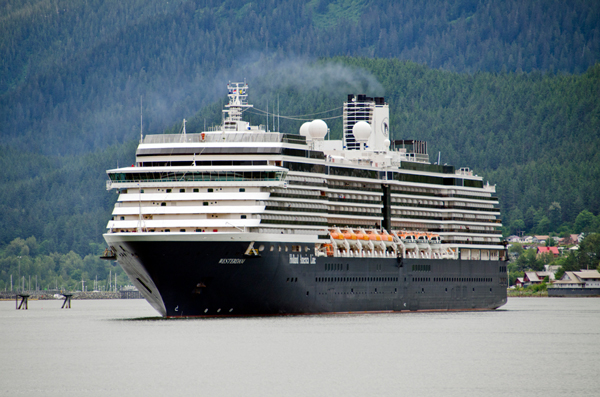
Southeast Alaska’s economy is poised to take a hit as most of the season’s cruises cancel. But a rough year for tourism could be a good moment for science. No cruise ships or tour buses mean researchers will be able to measure the region’s baseline air quality.
Last year, Southeast residents logged forty-five air quality complaints against cruise ships with the state’s Department of Environmental Conservation. Nine of them were in Skagway.
But Skagway Mayor Andrew Cremata said the number logged with city hall is many times that.
“I’d probably put it in the neighborhood of 60 to 70 last year that I personally got, I don’t know about the official number,” he said.
Cremata said one cruise ship company agreed to monitor their emissions this summer. But now that most of the town’s projected arrivals are canceled due to COVID-19 safety concerns, Cremata and regional scientists are interested in a different data set: the baseline.
“It’s something completely different and that’s finding out what the difference is during this time of year now that we have a scenario where there are no buses, very few cars, no cruise ships, fewer planes, to kind of see how that compares,” Cremata said.
The cruise ship industry maintains that the pollution people see is really just vapor—ships mostly use scrubbers to clean the fumes from their heavy oil engines before it’s pumped into the air above port cities.
So the COVID-19 pandemic has the unintended result of providing researchers with something like a control experiment: what is the air quality like in Southeast Alaska without cruise ships?
“I think there is a potential to learn something, for sure,” said Michael Bower, the Program Manager for Southeast Alaska’s Inventory and Monitoring Network.
It’s part of the National Park Service’s regional effort to monitor the health of the ecosystem. He said the air quality program is in early stages, but should be operational in a few weeks. In prior years, he’s seen evidence that increased traffic in Skagway over the summer may affect the air quality.
“When we have done this direct sampling in the past we have had elevated concentrations of nitrogen oxides as well as sulfur dioxide at one of the sites that we’ve sampled that’s near downtown. Whereas we didn’t necessarily have elevated concentrations at other sites that were farther from from the hub of activity in Skagway,” he said.
Those elevated pollutant concentrations made Skagway a priority for Bower’s group for the past few years. He’s not out policing the industry—he says the study also looks at the effects of wildfire season on air quality.
Bower’s monitoring will be carried out in partnership with Skagway’s Klondike Gold Rush National Historical Park. Superintendent Jason Taylor says last year’s wildfires sparked serious air quality concerns, but the park didn’t collect data then.
“When you don’t have data to base decisions on, you’re kind of flying in the dark, right? It’s just a giant gray space and you feel like you need to make or want to make a decision to protect people. And you can’t, because you don’t know what the right decision is,” he said.
The data they plan to collect this year is going to help him make health and safety decisions about when to close the park to visitors and staff. The park is even hiring a new biologist to assist with the effort.
The network usually monitors in Glacier Bay and near Sitka, but this year it’s unlikely. Skagway has an existing partnership with the Department of Environmental Conservation that makes testing possible this year, with increased social distance and travel restrictions.
The Department of Environmental Conservation also conducted an air quality study last year in Juneau. It is unclear at this time whether or not they will continue.
